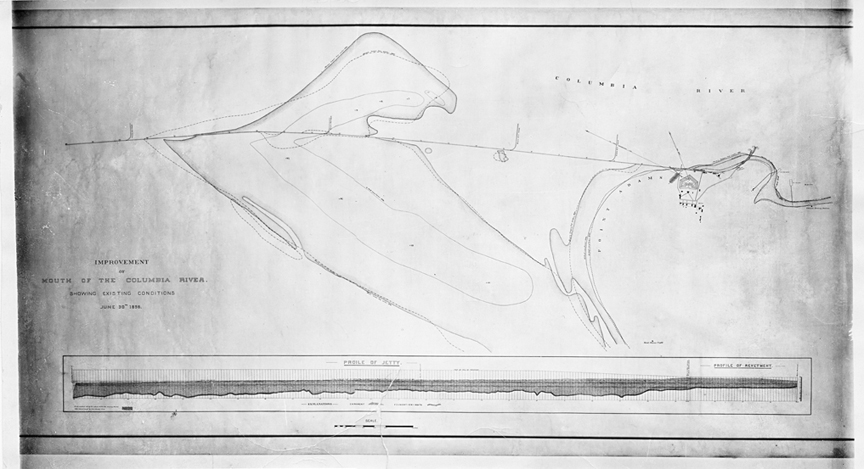- Catalog No. —
- ba018618
- Date —
- June 30, 1896
- Era —
- 1881-1920 (Industrialization and Progressive Reform)
- Themes —
- Transportation and Communication
- Credits —
- Map Collection, Drawer 12, Oregon Historical Society Research Library
- Regions —
- Coast Columbia River
- Author —
- Unknown
Improvement of Mouth of the Columbia River
This June 30, 1896, map depicts the south jetty of the Columbia River shortly after it was completed by federal engineers in 1895. The U.S. Army Corps of Engineers built the jetty to concentrate the flow of water from the river into the ocean, thereby creating a deeper, more stable channel through which ships could navigate. The map depicts the jetty's underwater composition and its location, which extends from Point Adams across Clatsop Spit and into the Pacific Ocean. Four "rock groins" short segments of the jetty perpendicular to the main line, are illustrated on the jetty's north side. Their purpose was to prevent the tide from displacing sand surrounding the jetty.
Throughout the early history of shipping in the Pacific Northwest, the mouth of the Columbia River was renowned for being treacherous. Severe weather and constantly-shifting water depths made crossing the Columbia bar a dangerous chore. The problem magnified during the second half of the nineteenth century as ships grew in size and could no longer travel safely through the natural channels of the river's entrance, which ranged in depth from seventeen to twenty-one feet. Recognizing that hazardous conditions along such an important transportation artery were potentially detrimental to trade and commerce, Congress answered pleas from shipping lobbyists and other concerned citizens by authorizing the construction of a jetty in 1884.
The U.S. Army Corps of Engineers began construction on the ambition endeavor in April 1885. After ten years of dangerous work, the south jetty grew to be four and one-half miles long and thirty feet high. The depth of the channel increased to thirty feet at low tide, the Army Engineers' goal. The cost of the successful engineering feat was just under $2,025,000-forty-five percent below budget.
Further reading:
Gibbs, James A. Pacific Graveyard: A Narrative of Shipwrecks Where the Columbia Meets the Pacific Ocean. Portland, Oregon, 1965.
"The Columbia River Jetties." Quarterdeck Review 15, 2 (1988): 4-5.
Written by Sara Paulson, © Oregon Historical Society, 2007.
